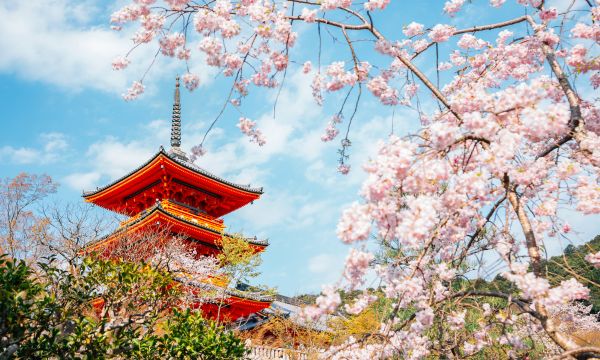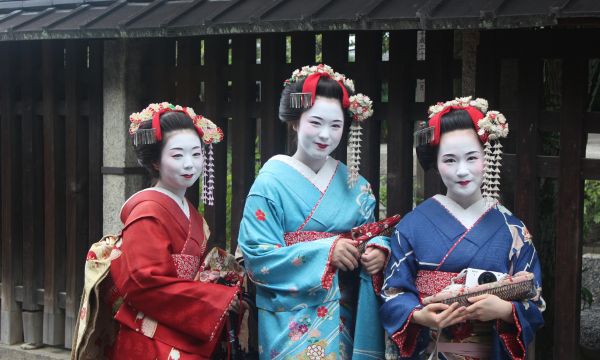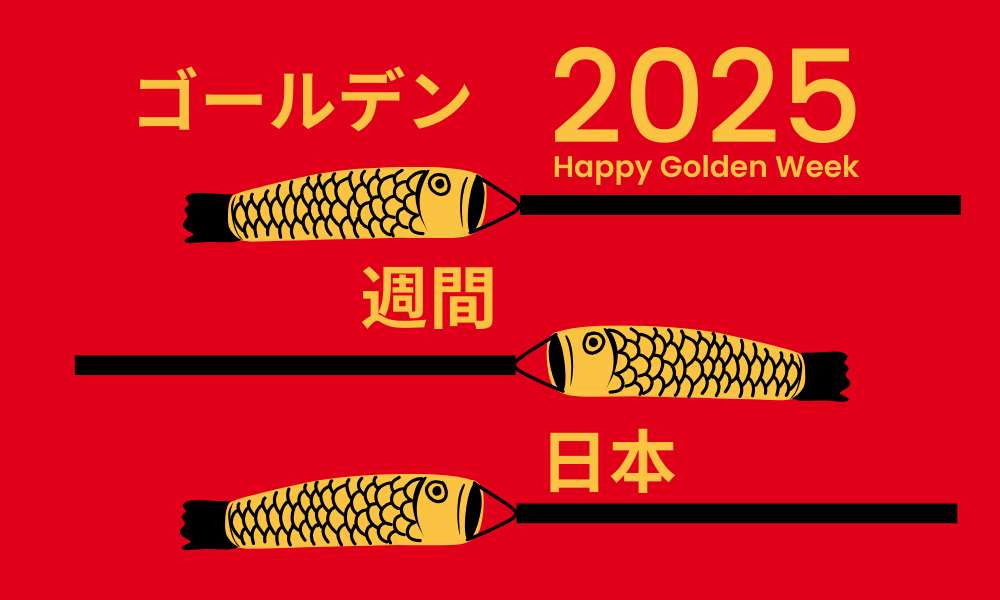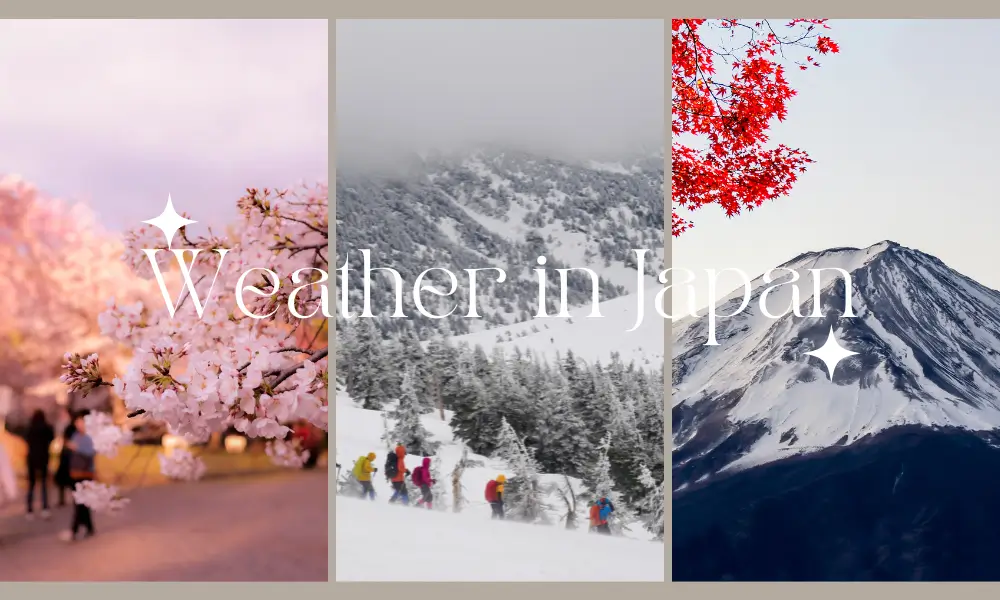Planning a trip to Japan in 2025? Understanding the country’s diverse climate is key to fully experiencing its magic. Weather in Japan varies dramatically throughout the year, from cherry blossom springs to snowy winters and from humid summers to colorful autumns.
Each month brings unique weather patterns that can significantly impact your travel experience. Whether you dream of witnessing the sakura bloom in spring, exploring vibrant summer festivals, catching the autumn foliage, or hitting the ski slopes in winter, timing is everything.
With temperatures ranging from below freezing in Hokkaido to tropical warmth in Okinawa, Japan’s regional climate differences add another layer to your planning. Let’s explore weather patterns in Japan month by month so you can choose the perfect time for your 2025 adventure and pack accordingly.
For more detailed travel advice, check out this handy guide on leagal drinking age in Japan
Show the relevant content
Toggle- Why Understanding Japan’s Weather Matters
- The Risks of Not Planning for Japan’s Weather
- A Month-by-Month Guide to Japan’s Weather in 2025
- Weather in Japan in January: Cold and Snowy
- Weather in Japan in February: Still Winter, but Slightly Milder
- Weather in Japan in March: Spring Begins
- Weather in Japan in April: Cherry Blossom Season
- Weather in Japan in May: Warm and Sunny
- Weather in Japan in June: Rainy Season Starts
- Weather in Japan in July: Hot, Humid, and Rainy
- Weather in Japan in August: Hottest Month
- Weather in Japan in September: Typhoon Season
- Weather in Japan in October: Cool and Comfortable
- Weather in Japan in November: Autumn Colors
- Weather in Japan in December: Winter Returns
- Japan’s Weather by Region
- Monthly Weather Table for Japan (2025)
- Case Study: How Weather Impacts Travel in Japan
- Climate Trends and What to Watch For
- Tips for Traveling in Japan by Month
- Quick Comparison: Weather in Major Japanese Cities (May Example)
- What to Remember About Japan’s Weather
- Final Thoughts
- 1. What are the four main seasons in Japan, and what are their typical characteristics?
- 2. When is Japan’s rainy season, and what should travelers expect?
- 3. What is the average temperature in Japan during summer?
- 4. Does it snow in Japan, and if so, where and when?
- 5. When is typhoon season in Japan and which areas are most affected?
- 6. What is the best time to visit Japan for cherry blossoms or autumn leaves?
- 7. How does Japan’s geography affect its weather patterns?
- 8. What should I do to stay safe during extreme weather events in Japan?
- 9. Are there any special weather-related festivals in Japan?
- 10. Where can I find up-to-date weather information for Japan during my trip?
Why Understanding Japan’s Weather Matters
Many travelers arrive in Japan expecting one kind of weather, only to find something completely different. You may plan to see cherry blossoms but arrive too late. Or you pack for warm weather but end up in a rainstorm. Not knowing what to expect can lead to disappointment, wasted money, or even unsafe situations.
Japan’s climate is unique because the country stretches from the chilly north of Hokkaido down to subtropical Okinawa. Each region and month brings different weather patterns, from typhoons to snowstorms. If you want to see the best of Japan-like cherry blossoms, autumn leaves, or snow monkeys-you need to know when and where to go.
The Risks of Not Planning for Japan’s Weather
Imagine hiking Mount Fuji in July, only to find it’s closed due to heavy rain. Or visiting Tokyo in August, sweating through the hottest, most humid days of the year. You may see it in September, not knowing it’s typhoon season and your beach trip gets rained out.
Not understanding Japan’s monthly weather can mean:
- Packing the wrong clothes (too hot, too cold, or not waterproof)
- Missing seasonal events like cherry blossoms or autumn leaves
- Getting caught in heavy rain, snow, or even typhoons
- Paying more for travel during busy seasons or holidays
- Feeling uncomfortable or even unsafe
Knowing the weather in Japan for each month is essential if you want to have fun and make the most of your trip.
A Month-by-Month Guide to Japan’s Weather in 2025
Let’s break down the weather in Japan month by month so you’ll know what to expect and how to plan.
Weather in Japan in January: Cold and Snowy
- Average temperature: 5°C (41°F)
- Rain/Snow: Moderate
- What to expect: January is winter across Japan. Northern areas like Hokkaido get lots of snow, which is great for skiing and snowboarding. Central and southern cities (Tokyo, Osaka, Kyoto) are cold but usually dry. Bring a warm coat, gloves, and a hat if you visit now.
Weather in Japan in February: Still Winter, but Slightly Milder
- Average temperature: 6°C (43°F)
- Rain/Snow: Low
- What to expect: It’s still winter, especially in the north. Ski resorts are busy. In Tokyo, it’s cold, but there are more sunny days. Pack warm clothes and check for winter festivals, like the famous Sapporo Snow Festival1.
Weather in Japan in March: Spring Begins
- Average temperature: 10°C (50°F)
- Rain/Snow: Low
- What to expect: Early March is chilly, but cherry blossoms bloom in southern Japan by late March. It’s a great time for sightseeing. Bring a jacket and an umbrella for occasional rain.
Weather in Japan in April: Cherry Blossom Season
- Average temperature: 15°C (59°F)
- Rain/Snow: Moderate
- What to expect: April is one of the best months to visit. Cherry blossoms (sakura) are in full bloom in most cities. The weather is mild and pleasant. Pack layers and a light raincoat for spring showers.
Weather in Japan in May: Warm and Sunny
- Average temperature: 20°C (68°F)
- Rain/Snow: Moderate, about 10–16 rainy days
- What to expect: May is the last month of spring. Days are warm and sunny, with flowers everywhere. In central Japan (Tokyo, Kyoto, Osaka), highs are expected to be around 23°C (73°F). There’s some rain, so bring an umbrella. Hokkaido still has cherry blossoms in early May, while Okinawa starts to feel humid.
Weather in Japan in June: Rainy Season Starts
- Average temperature: 25°C (77°F)
- Rain/Snow: High (wettest month in many regions)
- What to expect: June is the rainy season (tsuyu) for most of Japan, except Hokkaido. Expect frequent rain, cloudy skies, and rising humidity. Temperatures climb, especially in the south. Pack waterproof shoes, a raincoat, and an umbrella.
Weather in Japan in July: Hot, Humid, and Rainy
- Average temperature: 28°C (82°F)
- Rain/Snow: High
- What to expect: The rainy season continues into early July, then the weather turns hot and humid. Summer festivals and fireworks begin. In the mountains, it’s cooler and great for hiking. Bring light, breathable clothes, and sun protection.
Weather in Japan in August: Hottest Month
- Average temperature: 30°C (86°F)
- Rain/Snow: High
- What to expect: August is the hottest month, especially in cities like Tokyo (up to 31°C/88°F). Humidity is high. It’s also typhoon season, especially in Okinawa and southern Japan. Beaches are popular but be prepared for sudden storms. Stay hydrated and wear sunscreen.
Weather in Japan in September: Typhoon Season
- Average temperature: 26°C (79°F)
- Rain/Snow: Moderate to high
- What to expect: September is the second rainiest month, with typhoons bringing heavy rain and wind, especially in the south. Temperatures start to drop, and late September feels like autumn. Pack a rain jacket and check weather forecasts before traveling.
Weather in Japan in October: Cool and Comfortable
- Average temperature: 20°C (68°F)
- Rain/Snow: Low
- What to expect: October is a great time to visit. The weather is cool and dry, and autumn leaves begin to appear in the north. Perfect for hiking and exploring cities. Bring a sweater and a light jacket.
Weather in Japan in November: Autumn Colors
- Average temperature: 14°C (57°F)
- Rain/Snow: Low
- What to expect: November is famous for its beautiful fall foliage. Central and southern Japan are mild and sunny, while the north gets colder. There’s little rain, so it’s perfect for outdoor activities. Pack layers for chilly mornings and evenings.
Weather in Japan in December: Winter Returns
- Average temperature: 8°C (46°F)
- Rain/Snow: Moderate
- What to expect: December is the start of winter. Northern Japan sees snow, while cities like Tokyo are cold but usually dry. Christmas lights and winter festivals are common. Bring warm clothes and enjoy the hot springs (onsen) to stay warm.
Japan’s Weather by Region
Japan has several climate zones:
- Hokkaido (North): Long, cold winters with lots of snow. Cool summers.
- Central Japan (Tokyo, Kyoto, Osaka): Four distinct seasons. Hot, humid summers and mild winters.
- Okinawa (South): Subtropical. It is warm all year, with a rainy season and typhoons in summer and autumn.
Monthly Weather Table for Japan (2025)
| Month | Avg Temp (°C) | Avg Temp (°F) | Rain/Snow |
| January | 5 | 41 | Moderate |
| February | 6 | 43 | Low |
| March | 10 | 50 | Low |
| April | 15 | 59 | Moderate |
| May | 20 | 68 | Moderate |
| June | 25 | 77 | High (Rainy) |
| July | 28 | 82 | High (Rainy) |
| August | 30 | 86 | High (Typhoons) |
| September | 26 | 79 | Moderate/High |
| October | 20 | 68 | Low |
| November | 14 | 57 | Low |
| December | 8 | 46 | Moderate |
Case Study: How Weather Impacts Travel in Japan
Let’s look at a real example. In May 2025, a family from Australia planned a trip to Japan, hoping for dry, sunny days. They visited Tokyo, Kyoto, and Hokkaido. Tokyo and Kyoto enjoyed warm weather (around 23°C/73°F), but it rained about 10 days out of the month. When they reached Hokkaido, they caught the last cherry blossoms of the year and cooler temperatures (around 18°C/64°F).
They packed light jackets and umbrellas, which helped them stay comfortable and dry. Their favorite activities included visiting flower parks, hiking in the mountains, and enjoying local food. Because they checked the weather in Japan before their trip, they could plan indoor activities on rainy days and outdoor adventures when it was sunny.
Climate Trends and What to Watch For
Japan’s climate is changing. Over the past 100 years, the annual average temperature has risen by about 1.4°C. Scientists expect more extremely hot days in the future, especially in cities. Heavy rainfall events are becoming more common, and typhoons may be stronger. Snowfall is decreasing in many areas, except for the far north.
What does this mean for travelers?
- Summers may feel hotter and more humid.
- Rainy and typhoon seasons may bring heavier downpours.
- Winters are milder in many cities, but ski resorts still get lots of snow.
Tips for Traveling in Japan by Month
- January–February: Great for skiing and snowboarding. Visit Sapporo for the Snow Festival. Pack warm clothes.
- March–April: Perfect for cherry blossoms. Book hotels early-this is peak travel season.
- May: Enjoy sunny days and flowers. Hokkaido is less crowded and still has blossoms.
- June–July: Expect rain and humidity. Pack waterproof gear. Visit Hokkaido for drier weather.
- August: Hot and humid. Stay hydrated, use sunscreen, and check for typhoons.
- September: Typhoon season. Watch weather forecasts, especially for southern Japan.
- October–November: Best for autumn leaves. Cool, comfortable weather-great for hiking and sightseeing.
- December: Enjoy winter lights, festivals, and hot springs. Ski resorts are open.
Quick Comparison: Weather in Major Japanese Cities (May Example)
| City | Min Temp (°C) | Max Temp (°C) | Rainfall (mm) |
| Sapporo | 9 | 18 | 56 |
| Tokyo | 15 | 24 | 140 |
| Kyoto | 15 | 25 | 151 |
| Osaka | 16 | 25 | 137 |
| Hiroshima | 15 | 24 | 170 |
| Okinawa | 22 | 27 | 245 |
What to Remember About Japan’s Weather
- Japan has four seasons, but the weather changes from north to south.
- Spring (March- May) and autumn (September–November) are the best times to visit for mild weather and beautiful scenery.
- Summer (June–August) is hot, humid, and rainy, with typhoons in late summer.
- Winter (December–February) is cold, with snow in the north and mild weather in the south.
- Always check the weather forecast before your trip and pack accordingly.
Final Thoughts
Understanding the weather in Japan month by month helps you make the most of your adventure. Whether you want to see cherry blossoms, hike in the mountains, or ski in deep snow, planning around Japan’s climate means more fun and fewer surprises.
Check the Japan weather forecast for 2025, pack for the season, and get ready to enjoy everything this amazing country has to offer!
FAQs about the weather in Japan:
1. What are the four main seasons in Japan, and what are their typical characteristics?
Japan has four distinct seasons: a warm spring, a hot and humid summer, a cool autumn, and a cold winter. Each season brings different temperatures and weather patterns across the country.
2. When is Japan’s rainy season, and what should travelers expect?
The rainy season, called tsuyu, usually starts mid-June and lasts until mid-to-late July in most of Japan, except Hokkaido. Okinawa’s rainy season begins in mid-May and ends in late June. Expect frequent rain and higher humidity during this time.
3. What is the average temperature in Japan during summer?
In summer, average temperatures range from about 22°C (72°F) in Hokkaido to around 25°C (77°F) in Tokyo and up to 28°C (82°F) in Okinawa. Many cities, like Tokyo, often experience days above 30°C (86°F).
4. Does it snow in Japan, and if so, where and when?
Japan snows, especially in northern regions like Hokkaido and along the coast of the Sea of Japan. The heaviest snowfall occurs from December to February, with some areas experiencing record-breaking snowfalls.
5. When is typhoon season in Japan and which areas are most affected?
Typhoon season in Japan runs from June to December, peaking between July and September. Southern parts of the country, including Okinawa, are most at risk, but typhoons can affect many regions.
6. What is the best time to visit Japan for cherry blossoms or autumn leaves?
Depending on the region, the best time for cherry blossoms is usually late March to early April. Late October to November is ideal for autumn leaves, especially in central and northern Japan.
7. How does Japan’s geography affect its weather patterns?
Japan stretches about 3,000 km from north to south, with climates ranging from subarctic in Hokkaido to subtropical in Okinawa. Mountainous terrain and proximity to the ocean also create regional differences in weather.
8. What should I do to stay safe during extreme weather events in Japan?
Stay updated with weather forecasts from the Japan Meteorological Agency, follow local advice, and download safety apps like Safety Tips or NERV Disaster Prevention. Prepare emergency supplies and know evacuation routes, especially during typhoons, heavy snow, or earthquakes.
9. Are there any special weather-related festivals in Japan?
Yes, Japan hosts several weather-related festivals, such as the Sapporo Snow Festival in Hokkaido during winter, which features large snow and ice sculptures.
10. Where can I find up-to-date weather information for Japan during my trip?
The latest weather forecasts and warnings are available on the Japan Meteorological Agency website, travel safety apps, and local news sources.










